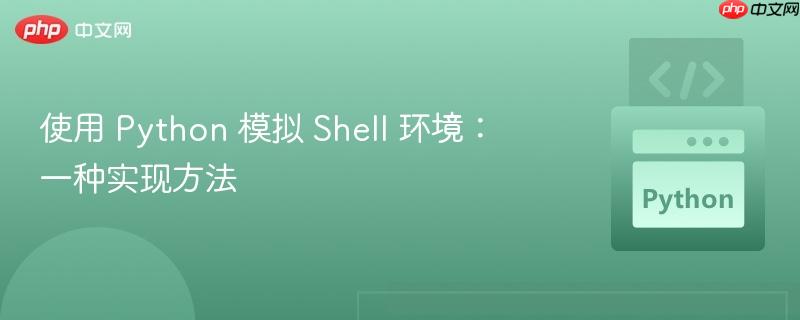
本文介绍了一种在 Python 中模拟 Shell 环境的方法,用于执行用户输入的命令,例如 `ls`、`cd` 等。重点在于解决连续执行多个命令,特别是那些依赖于先前命令(如改变当前目录)的问题。文章提供了一种通过创建自定义函数来处理系统状态变化命令的解决方案,并讨论了其优缺点。
在开发 Discord 机器人或其他需要执行系统命令的应用时,模拟 Shell 环境可能非常有用。一个常见的需求是允许用户通过机器人执行诸如 ls (列出目录内容), cd (改变当前目录) 等命令。然而,直接使用 subprocess 模块可能会遇到一些挑战,特别是当需要连续执行多个依赖于先前命令状态的命令时。
以下提供一种解决方案,虽然并非完美,但适用于小型项目,特别是当只需要模拟少量命令时。
核心思路:
立即学习“Python免费学习笔记(深入)”;
与其尝试在一个持续的 subprocess 中运行所有命令,不如为每个命令单独创建一个 subprocess,并为那些会影响系统状态(例如当前工作目录)的命令创建自定义函数来处理。
示例代码:
import subprocess
import os
class CommandLine:
def __init__(self):
self.dir = os.getcwd() # 记录当前目录
def run(self, command: str):
try:
result = subprocess.run(command, shell=True, check=True, capture_output=True)
if result.stderr:
return result.stderr.decode('utf-8')
else:
return result.stdout.decode('utf-8')
except subprocess.CalledProcessError as e:
return e.stderr.decode('utf-8') # 处理命令执行错误
def cd(self, new_dir: str):
try:
os.chdir(new_dir)
self.dir = os.getcwd() # 更新当前目录
return f"Changed directory to: {self.dir}"
except FileNotFoundError:
return "Directory not found."
except NotADirectoryError:
return "Not a directory."
except OSError as e:
return f"Error changing directory: {e}"
# 示例用法
cli = CommandLine()
# 执行 ls 命令
output = cli.run("ls -l")
print(output)
# 改变目录
output = cli.cd("/tmp") # 将目录更改为 /tmp
print(output)
# 再次执行 ls 命令,查看 /tmp 目录内容
output = cli.run("ls -l")
print(output)代码解释:
注意事项:
总结:
这种方法提供了一种简单直接的方式来模拟 Shell 环境,特别适合于只需要模拟少量命令的小型项目。通过为每个命令单独创建 subprocess 并为影响系统状态的命令创建自定义函数,可以有效地解决连续执行命令的问题。然而,需要注意安全性问题,并根据实际需求进行适当的调整和扩展。对于更复杂的 Shell 环境模拟,可能需要考虑使用更高级的库或方法。
以上就是使用 Python 模拟 Shell 环境:一种实现方法的详细内容,更多请关注php中文网其它相关文章!

每个人都需要一台速度更快、更稳定的 PC。随着时间的推移,垃圾文件、旧注册表数据和不必要的后台进程会占用资源并降低性能。幸运的是,许多工具可以让 Windows 保持平稳运行。

Copyright 2014-2025 https://www.php.cn/ All Rights Reserved | php.cn | 湘ICP备2023035733号